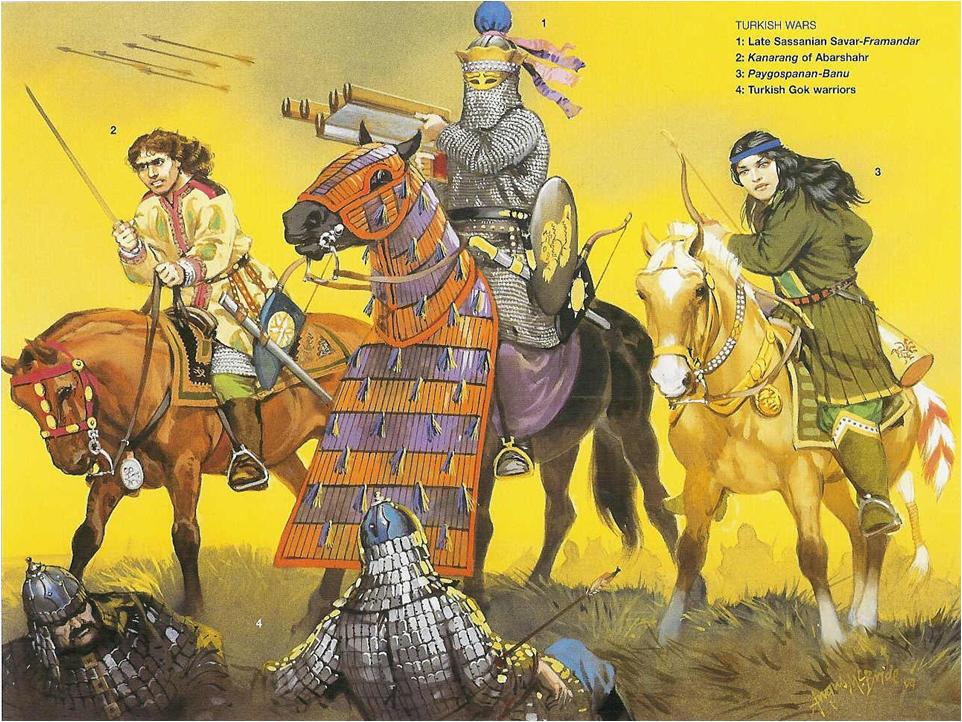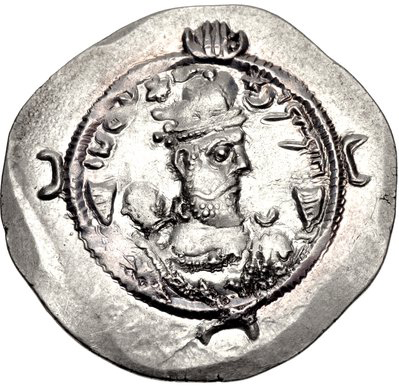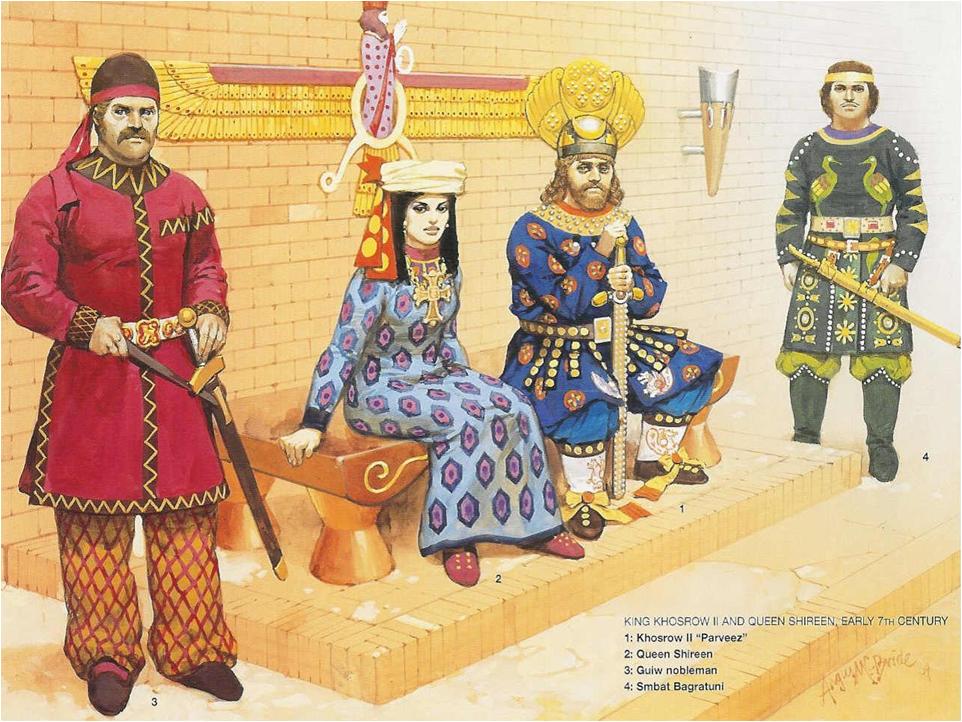The article below by the late Shapour Shahbazi’s regarding Bahrām VI Chobin (Čōbīn) was originally published in the Encyclopedia Iranica on December 15, 1988 and last updated: on August 24, 2011. This article is also available in print (Vol. III, Fasc. 5, pp. 514-522). Kindly note that none of the images and accompanying descriptions inserted below appear in the original Encyclopedia Iranica posting.
=======================================================
Bahrām VI Čōbīn, chief commander under the Sasanian Hormozd IV and king of Iran in 590-91, was a son of Bahrāmgošnasp, of the family of Mehrān, one of the seven great houses of the Sasanian period (Justi, Namenbuch, p. 363 no. 23). First mentioned in Šāpūr’s Kaʿba-ye Zardošt inscription (“Arštāt, the Mehrān, from Ray,” see W. B. Henning, BSOAS 14, 1952, p. 510), the family remained the hereditary margraves of Ray and produced notable generals (Nöldeke, Geschichte der Perser, p. 139 n. 3). Bahrām was called Mehrbandak (Arm. Mehrevandak; Justi, loc. cit.), but his tall and slender physique earned him the nickname Čōbīn(a), var. Šōpēn “Javelin-like” (Šāh-nāma, Moscow, VIII, p. 377; cf. V. Minorsky, JRAS, 1933, p. 108). Bahrām started as margrave of Ray (Masʿūdī, Morūj II, p. 213), commanded a cavalry force which captured Dārā in 572 (Theophylactos Simocatta, 3.18.10f.), became Spahbaḏ of the North (i.e., satrap of Azerbaijan and Greater Media) under Hormozd IV, and fought a long but indecisive campaign against the Byzantines in northern Mesopotamia (Dīnavarī, p. 94; cf. Šāh-nāma, Moscow, VIII, p. 388. For the campaign see M. J. Higgins, The Persian War of Emperor Maurice, Washington, 1939, pp. 35ff.). Late in 588, a horde of the Hephthalites, subjects of the Western Turks since 558, invaded eastern provinces of the Persian empire; and with the sanction and support of their overlords, reached Bādgīs and Herat. In a council of war, Bahrām was elected commander-in-chief of the Iranian army and satrap of Khorasan, furnished with a trained force, reportedly of 12,000 picked horsemen, and sent against the invaders whom Sasanian-based sources (as well as Theophylactos, 3.6) call Turks. Marching with remarkable speed, Bahrām first engaged and defeated the Western Turks and took the city of Balḵ. He then occupied the land of the Hephthalites, and crossing the Oxus won a resounding victory over the Eastern Turks, personally slaying their Great Ḵāqān (Ču-lo-hóu in Chinese records; J. Marquart, “Historische Glossen zu den alttürkischen Inschriften,” WZKM 12, 1898, pp. 189-90, and E. Chavannes, Documents sur les Toukiue

Sassanian forces counterattack the invading Turco-Hephthalites in the Sassanian Empire’s northeast; the figures in the above plate (1-late Sassanian Savar-Framandar, 2-Kanarang, 3-Paygospan and 4-Turkic Gok warriors) are based on reconstructions from Sassanian archaeological data such as the grotto of the armored knight inside the vault or Iwan at Taghe Bostan, the (post-Sassanian) metalwork work plate of Pur-e Vahman as well as East Iranian sources (For more information consult: Plate C, pp.53-54, 60-61, Elite Sassanian Cavalry-اسواران ساسانی-).
Meanwhile Hormozd had alienated the magnates by imprisoning and executing many renowned men, reducing the size of the cavalry force, and decreasing the army’s pay by 10 percent (Theophylactos, 3.13.16; Ṭabarī, tr. Nöldeke, pp. 264-68). Distrustful of Bahrām even before the eastern expedition (Yaʿqūbī, I, p. 188), Hormozd could not tolerate the popularity of his own general, and giving out that Bahrām’s reserving of a few choice items of the booty for himself was an indication of rebellion, he removed the victor from his posts, and sent him a chain and a spindle to show that he regarded him as a low slave “as ungrateful as a woman” (Dīnavarī, pp. 84ff.; see also Šāh-nāma, Moscow, VIII, pp. 397-98; Theophylactos, 3.6-8, says that Bahrām was again sent to the Roman front and was defeated in Albania, whereupon Hormozd disgraced him; Nöldeke, op. cit., p. 272 n. 3, favored this version in 1879, but one of the best non-Iranian sources, discovered ten years later, Die von Guidi herausgegebene syrische Chronik, tr. Th. Nöldeke, Vienna, 1893, p. 5, confirms that Bahrām rose in arms while still in the east). Bahrām’s noble descent, his cultured manners and generosity, his military accomplishments and leadership skills, and his daring and shrewdness had earned him so elevated a position among his devoted troops and the public (A. Christensen, Romanen om Bahram Tschobin, et Rekonstruktionsforsøg, Copenhagen, 1907) that their rebellion against the ungrateful king followed naturally. Having settled his quarrel with the Turks, Bahrām appointed a satrap for Khorasan (Ṯaʿālebī, op. cit., p. 658; Šāh-nāma, Moscow, VIII, pp. 418f.), then marched on Ctesiphon via Ray, and was joined by many veterans from the western front (Theophylactos, 4.1). To forestall his supremacy, the nobles in the capital seized power, and led by Bendōy and Bestām (q.v.) and supported by Prince Ḵosrow, they slew Hormozd and put his son on the throne. On Bahrām’s approach, however, they fled toward Azerbaijan but were intercepted and defeated, many of their troops deserting to Bahrām. Ḵosrow succeeded, through the heroic self-sacrifice of Bendōy, in escaping into Byzantine territory (Syrische Chronik, pp. 5ff.; Theophylactos, 4.9; Nöldeke, Geschichte der Perser, pp. 272ff., 418-19, 434; Dīnavarī, pp. 89ff.; Baḷʿamī, op. cit., pp. 1079ff.; Nehāya, apud Browne, JRAS, 1900, pp. 237f.; Ṯaʿālebī, op. cit., pp. 657ff.; Yaʿqūbī, I, pp. 190f.; Ebn Balḵī, p. 100; [Ps.-]Sebeos, tr. M. K. Patkanian, Essai d’une histoire de la dynastie des Sasanides, Paris, 1866, pp. 87ff. [= JA, 1866, pp. 187ff.]).
Bahrām entered Ctesiphon and proclaimed himself king of kings (summer, 590), claiming that Ardašīr, the upstart son of Sāsān the shepherd, had usurped the throne of the Arsacids, and now he was reestablishing their right (Šāh-nāma, Moscow, IX, pp. 29-32; Yaʿqūbī, I, p. 192; the humble origin of Ardašīr was already noted by Agathias, 2.27). He tried to support his cause with the following apocalyptic belief then current: The Sasanians had identified the Seleucid era (312 b.c.) with the era of Zoroaster (H. Lewy, JAOS 64, 1944, pp. 197ff.; S. H. Taqizadeh, JRAS, 1947, pp. 33ff.), thereby placing Ardašīr some 500 years after the prophet and leaving 500 years for the duration of their own dynasty (Šāh-nāma, Moscow, VII, pp. 90-91). The close of Zoroaster’s millennium was to witness chaos and destructive wars with the Xyōns (Hephthalites/Huns) and Romans, followed by the appearance of a savior (details and references in Czeglédy, op. cit., pp. 35ff.). And Bahrām had risen some 500 years after Ardašīr (so Šāh-nāma, Moscow, IX, p. 30), and had saved Iran from chaos, the Xyōns and the Romans; he therefore claimed to be and was hailed by many as the promised savior, Kay Bahrām Varjāvand (Czeglédy, op. cit., pp. 36-39). He was to restore the Arsacid empire and commence a millennium of dynastic rule (Šāh-nāma, Moscow, IX, pp. 60-62). He issued coins in his own name. They represent him as a majestic figure, bearded and wearing a crenellated crown adorned with two crescents of the moon; and they are dated to year 1 and 2 (R. Göbl, Sasanian Numismatics, Brunswick, 1971, p. 52).

Coin attributed to Bahram VI Chobin (Source: Public Domain originally by Classical Numismatic Group).
Bahrām’s hopes were unfulfilled. Many nobles and priests preferred to side with the inexperienced and less imposing Ḵosrow, who, in return for territorial concessions, had obtained a Byzantine force of 40,000 (Chronicle of Seʿert, in Patrologia Orientalis XIII/4, p. 466), and was now marching toward Azerbaijan, where an army of over 12,000 Armenians under Mūšel (cf. Dīnavarī, p. 94) and 8,000 Iranians gathered and led by Bendōy and Bestām ([Ps.-]Sebeos, tr. Patkanian, op. cit., p. 93) awaited him. Hoping to prevent a union of those forces, Bahrām left Ctesiphon with a much smaller army, but arrived too late. The two sides fought for three days in a plain near Lake Urmia, and on the eve of the fourth, Bendōy won over Bahrām’s men by pledging, in the name of Ḵosrow, their pardon and safety. In spite of his bravery and superb generalship, Bahrām was defeated, and his camp, children, and wives were captured. He himself left the battlefield, accompanied by 4,000 men, and since Ḵosrow had in the meantime sent a force to Ctesiphon and had secured it, the only road open was eastward. Bahrām marched to Nīšāpūr, defeating a pursuing royalist force and an army of a local noble of the Kārēn family at Qūmeš. Ceaselessly troubled, Bahrām finally crossed the Oxus, and was received honorably by the Ḵāqān of the Turks, entered his service and achieved heroic feats against his adversaries. Ḵosrow could not feel secure as long as Bahrām lived, and he succeeded in having him assassinated. The remainder of his troops returned to northern Iran and joined the rebellion of Bestām (Syrische Chronik, pp. 5-7; Theophylactos, 4ff.; [Ps.-] Sebeos apud Patkanian, op. cit., pp. 92ff.; Yaʿqūbī, I, pp. 192ff.; Dīnavarī, pp. 90-105; Ṭabarī, tr. Nöldeke, pp. 275-89; Nehāya, pp. 238-42; Baḷʿamī, op. cit., pp. 1083ff.; Higgins, op. cit., chaps. II and III; L. N. Gumilev, “Bakhram Chubin,” in Problemy vostokovedeniya III, 1960, pp. 228-41).
Given time and opportunity to deal with internal problems, Bahrām would have probably achieved no less than Ardašīr I had done, but he was faced with too many odds. It was not Ḵosrow but his superior Byzantine mercenaries who defeated Bahrām (Theophylactos, loc. cit.). The betrayal by his own brother, Gordōy, and the capture of his family severely limited his maneuvering ability. He was handicapped by the lack of cooperation from the bureaucrats, and the animosity of nobles unwilling to serve one of their own equals (Dīnavarī, p. 99; Theophylactos, 4.12; Ṯaʿālebī, op. cit., pp. 660f.). His own chivalry in letting Ḵosrow’s supporters leave the realm unmolested (Dīnavarī, p. 94), and in ignoring the escape of the resolute Bendōy, turned against him by giving his enemies the possibility to unite. His religious tolerance (see G. Widengren, Iranica Antiqua 1, 1961, pp. 146-47) alienated the powerful clergy (Theophylactos, 4.12f.; Ṭabarī, tr. Nöldeke, p. 282). Even the apocalyptic belief he put to use was masterfully turned against him when Ḵosrow employed the following propaganda devices. He initially remitted one half of the annual poll-tax (Dīnavarī, p. 102), and bestowed riches on great fire temples (cf. Šāh-nāma, Moscow, IX, pp. 104f., 136). He then ordered his secretaries to publish an account of the events from the rise of Bahrām to the restoration of Ḵosrow (Bayhaqī, al-Maḥāsen wa’l-masāwī, ed. F. Schwally, Giessen, 1902, p. 481) wherein Bahrām was pictured as a soldier of fortune and an evil usurper. Finally, Ḵosrow circulated a modified version of the apocalyptic prophecy according to which the end of Zoroaster’s millennium was to witness the arrival with a vast army of a lowly false pretender from Khorasan, his usurpation of the throne, and his swift disappearance, followed by a short period of foreign rule over Iran and the restoration of peace and prosperity by a “victorious king” (aparvḕ xvatāy) who would even take many cities from the Romans; and since Ḵosrow had restored the kingdom and destroyed the lowly usurper Bahrām, he now claimed to be the true savior of Iran, and assumed the title Aparvēž, Parvēz (Czeglédy, op. cit., pp. 32ff.).

Court of Khosrow II and his queen Shirin – Smbat Bagratuini (Figure 4) was to replicate the spectacular successes of the Sassanian military against a renewed Turco-Hephthalite invasion of the Sassanian empire from the northeast in 618-619 CE (For more information on color plates and sources consult: Plate F, pp.53-54, 62, Elite Sassanian Cavalry-اسواران ساسانی-).
However, Bahrām’s memory was immortalized in a masterfully composed Pahlavi romance, the Bahrām Čōbīn-nāma (Masʿūdī, Morūj II, p. 223; Fehrest, p. 305; Baḷʿamī, op. cit., p. 1081), which was translated by Jabala b. Sālem (Fehrest, loc. cit.), and found its way—intermingled with another account, favorable to Ḵosrow Parvēz—into the works of Dīnavarī (pp. 81-104), Ferdowsī (Šāh-nāma, Moscow, VIII, pp. 331-430 and IX, pp. 10-178), Baḷʿamī (op. cit., pp. 1073ff.), and the Nehāya (pp. 233ff.). The picture of Bahrām in the romance is that of an illustrious knight of kingly origins and noble disposition, a superb, highly educated and disciplinarian general, and a witty, just, and wise king. He is the best archer, and comes from the family of Mēlād (Mithridates/Mehrdād) the Arsacid, himself of the line of Kay Āraš (q.v.), son of Kay Qobād (who is here confused with the famous archer: J. Marquart, ZDMG 69, 1895, pp. 633-35). When Iran is simultaneously attacked by the Romans, the Ḵazars, the Arabs, and the Turks, he saves the empire by crushing the most dangerous enemy, the Turks; and he takes action against Hormazd who had unjustly disgraced him, only after his troops and an assembly of nobles urge him to do so. His accession to the throne is sanctioned by the nobles, and he fights for his right with gallantry and pluck. Above all, he is a man of his word, devoted to his men and his fatherland. The novel describes details of his life, thoughts and deeds with such vividness and moving affection that its reflection in the Šāh-nāma counts as one of the masterpieces of Persian literature (Nöldeke, Geschichte der Perser, pp. 474-78). It clearly was published while Bahrām’s memory was still very much alive, and its form and main features have been restored by Arthur Christensen (op. cit.).
Bahrām is credited with the writing of a manual on archery (Fehrest, p. 304). He was survived by three sons: Šāpūr, who supported Bestām’s rebellion and was executed (Syrische Chronik, p. 9); Mehrān, whose own son, Sīāvoš, King of Ray, fell fighting the Arabs in 643 (Justi, Namenbuch, p. 300 no. 9); and Nōšrad, the ancestor of the Samanids (Bīrūnī, Chronology, p. 48). The popularity of Bahrām persisted in Iranian nationalist circles long after his death. Thus, Senbād could claim that Abū Moslem (q.v.) had not died but was staying with the Savior (Mahdī) in a “Brazen Hold” (i.e., Bahrām’s residence in Turkistan), and will soon return (Czeglédy, op. cit., pp. 40-41 citing Neẓām al-molk, Sīar al-molūk [Sīāsat-nāma], ed. H. Darke, 1347 Š./ 1968, p. 280).



